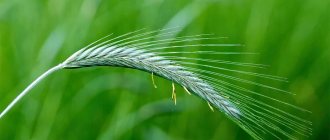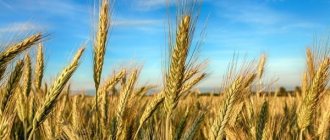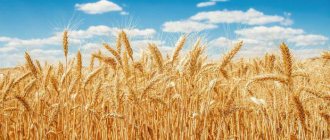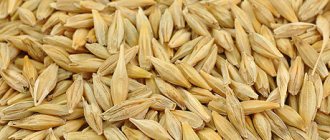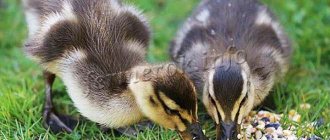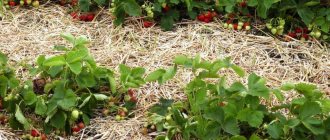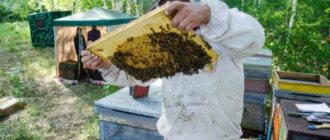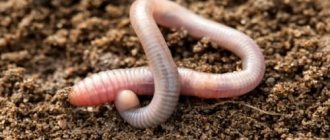Winter rye is the most important agricultural crop in the non-chernozem zone. In addition, it is an effective green manure. We will tell you in detail about its cultivation later in the article.
There are spring and winter cereals. Spring cereals are sown in the spring and ripen by summer. Winter crops are sown in late summer or autumn in order to get a harvest in spring or early summer.
Description of winter rye
Rye is a herbaceous plant, annual or perennial, belonging to the large family of cereals. Its name in Latin is Secale cereale, which means “sowing rye”. Within the species there are wild subspecies and over forty cultivated varieties. Plant differences relate to the following points:
- appearance and nutritional characteristics of grains;
- spine development;
- ear length;
- pubescence of the stem.
Root system
Rye has a fibrous root system, buried 1-2 m deep. This plant has powerful and developed roots, which are especially effective on light sandy soils. Rye roots, consisting of primary (embryo) and secondary (nodal) roots, quickly absorb nutrients contained in poorly soluble compounds.
The grain, immersed in the soil, forms 2 tillering nodes. One is located in depth, the second is near the surface, and it becomes the main one. Rye is characterized by intensive tillering - the plant forms from 4 to 8 shoots, and if favorable conditions are created - 50-90.
Stem
The rye stalk is a hollow straw consisting of several knees (from 4 to 7) connected by nodes. The lower internodes are thicker than the upper ones - 6-7 mm versus 2-4 mm. The stem is erect, pubescent under the spike, and then bare. The height of cultivated rye is limited to 1.5 m, wild species are higher - up to 1.8 m or more.
The stem and leaves are green, but due to the waxy coating they appear bluish. As they ripen, the color of the stem and leaves changes, first becoming gray-green, then gray-yellow and finally golden yellow.
Ear
Rye has an inflorescence in the form of a spike, consisting of 2 or 3 flowering spikelets attached to the stem. The shape of the grain is oblong or oval, slightly flattened on the sides. The top of the grain is bare or pubescent. Each variety of rye has its own ear length; it varies between 8-17 cm.
The weight of the grain depends on the variety:
- for large-grain varieties, 100 seeds weigh more than 38 g;
- for varieties with grains above average size - 30-38 g;
- for varieties with medium-sized grains – 20-30 g;
- for small-grain varieties - up to 20 g.
Rye grains vary in size, shape and color. Grain parameters:
- length – 5-10 mm;
- thickness – 1.5-3 mm;
- width – 1.5-3.5 mm.
The grains can take the form:
- oval – length refers to width 3.3 or less;
- elongated - length refers to a width greater than 3.3.
The surface has noticeable transverse wrinkles. The grain can be white, greenish, gray, yellow or dark brown.
Rye is a cross-pollinated plant and is wind pollinated. There are also self-pollinating varieties - they were bred for regions with risky agriculture to eliminate the risks associated with unfavorable weather.
Rye is one of the few crops that has two forms - spring and winter. The latter has higher yields, but it can only be grown in regions where mild winters are combined with sufficiently high snow cover. Such conditions help winter crops to survive the winter safely.
Botanical features
Rye has a fibrous root system that penetrates to a depth of two meters and can grow quite easily on sandy soils. High physiological activity allows crops to absorb useful elements from the soil, represented by poorly soluble compounds, in the shortest possible time.
The hollow stem part of rye has five to six internodes. The stem is straight, bare along almost the entire length, except for the area directly under the ears. The average height of the stem, depending on the varietal characteristics, can be about 0.8-1.0 m. The leaves are broad-linear, flat, up to 30 cm long and 25 mm wide. At the base of the leaf blade there is a shortened tongue with short bare or pubescent ears covering the stem part.
Demand for sowing
Rye has food and feed value. In addition, this cereal crop is an excellent green manure. Bread is baked from rye, and its grain serves as feed for farm animals. Flour is fed to pigs, and bran is fed to cattle.
Rye is the most important national product of Russia, but since Soviet times its cultivation has been steadily declining. If in 1990 in the Russian Federation 8 million hectares were allocated for rye, then in recent years the gross harvest is 2.5-3 million tons. Wheat today turned out to be more profitable to grow than rye. However, Russia continues to be the leading producer of rye. Only Poland and Germany can compete with the Russian Federation. The most rye - 20% - is grown in Tatarstan and Bashkiria.
What plants is it suitable for?
Most summer residents sow this cereal under potatoes. This has its advantages. Rye prepares the soil well for planting vegetables . But rye roots are the favorite food of wireworms, the worst enemy of potatoes. This pest also causes great harm to the vineyard.
If you nevertheless decide to plant potatoes or grapes on your plot, it is recommended to sow the grain mixed with mustard or lupine.
The most ideal successors for rye : cucumbers, zucchini, tomatoes, radishes, peppers, beans, peas, pumpkin, raspberries, strawberries.
For which ones not?
Since rye and other cereals have common diseases and pests, this green manure is not suitable for further sowing of all cereal crops , even ornamental ones.
Also, rye is not planted together with vegetables and fruits , since it will take all the water and nutrients, thereby preventing other plants from fully developing.
Terrain and climate
Rye is a unique crop; it is the only representative of grains cultivated in any climatic regions - from Yakutia to hot South American countries. Winter rye is grown in many countries, but its main crops are concentrated in the USA and Europe.
Advantages of winter rye:
- low dependence on meteorological conditions;
- undemanding to soil fertility;
- stability of yields.
Rye grains lose germination faster than other grains - after 3-4 years, 70% of the seeds are no longer able to germinate.
Rye is very popular in Russia. It is especially actively grown in regions where other grains do not produce high yields due to difficult conditions - low temperatures, high humidity, few sunny days, etc.
In Russia, the leader in rye production is the Stavropol region. Here the highest average yields are up to 50 c/ha. Also, a lot of rye is grown in the Lipetsk and Moscow regions, in the Krasnodar region and the Kaliningrad region. And in Transbaikalia, Khabarovsk Territory, Yakutia, Buryatia and the Amur Region, rye is the main cereal crop.
Winter rye varieties
Winter rye varieties differ from each other in yield and quality characteristics. The most popular varieties are unpretentious, winter-hardy and productive:
- Tatarstan relay race. Variety from breeders of Tatarstan. Obtained as a result of systematic cyclic selection from many analogues. The plant is a diploid type with long prismatic ears. This mid-late variety with long but brittle awns is frost-hardy, resistant to powdery mildew and brown rust. The grains are large - 1000 pieces weigh 40 g. The growing season is 330 days. Height – 1.25 m. Productivity – 40-64 c/ha.
- Voskhod 2. Mid-season variety of domestic selection, bred specifically for the Non-Black Earth Region. Parental forms are Hybrid 2 and Kharkovskaya 60. The plant has a dense spike of prismatic shape, its length is 8-10 cm. The awns are long and coarse. The grains are elongated, yellow-gray. 1000 pieces weigh 30-35 g. Plant height – up to 1.5 m. Harvest – 40/50 c/ha. The growing season is 330 days. The variety is winter-hardy, but its immunity against major diseases is weak.
- Tatarskaya 1. The mid-season variety was obtained by selection from three dozen similar crops. A distinctive feature is a loose prismatic spike. The awns are long. The grains are medium size, yellow. Weight of 1000 pieces - 30-35 g. Growing season 320-330 days. Plant height is 1.1 m. The stem is strong and winter-hardy. Immunity to powdery mildew and leaf rust is average. But the variety is resistant to root rot. Productivity is high even on infertile soils. Tatarskaya 1 is often used as a safety net. Productivity – 40-70 c/ha.
- Saratovskaya 7. Mid-season rye. The growing season is up to 330 days. Resistance to lodging. Thanks to the same plant height, cleaning is as efficient as possible. The grains are large - 100 g weigh about 4 g. High baking characteristics. Resistance to major rye diseases. The variety is cultivated mainly in the Volga region and its neighboring regions. Productivity – 45 c/ha.
- Bezenchukskaya 87 . A very frost-resistant variety that retains 98% of seedlings by spring. Tall plant - up to 1.25 m, resistant to lodging. High productivity potential. Resistance to moisture deficiency in the spring-summer season. There is not sufficient resistance to powdery mildew and brown rust. Recommended cultivation regions are the Middle Volga region, Central Black Earth and Volga-Vyatka regions. Productivity – 42-59 c/ha.
- Severskaya. The growing season is only 285 days. The variety is resistant to lodging, has a well-developed root system, winter-hardy, and drought-resistant. Not afraid of snow mold, brown rust, septoria and fusarium. Ripe grain does not fall off for a long time. Grain germination is high - up to 92%. 1000 pieces weigh 35 g. Productivity – 85 c/ha.
- Chulpan. A variety with a growing season of up to 345 days. The plant grows up to 1.3 m. The ears are light yellow. 1000 pieces weigh 28-30 g. Productivity – 60-85 c/ha. The variety is winter-hardy, productive, and drought-resistant.
Soil preparation
Tillage depends on the predecessor. Before sowing winter rye, the field is hulled to a depth of 7-8 cm, having first removed the predecessor. If harvesting is late, they do without peeling, immediately apply manure and plow the soil 30 cm deep. In the spring, the soil is harrowed and cultivated 2 times, first by 10 cm, then by 5-6 cm. In addition, in the summer, fields prepared for sowing winter wheat:
- cultivated;
- peel;
- disk;
- harrowing.
The interval between sowing and plowing is 1 month, this is necessary for the soil to settle. Plowing in forest-steppe and sub-taiga zones - 25-27 cm, in forest-steppe and steppe - 20-22 cm.
If fields are infested with stubborn weeds, it is recommended to treat with herbicides, such as Roundup, instead of just cultivation.
Optimal sowing dates
Sowing of winter rye begins no earlier than the average daily air temperature reaches 15-16°C. There should be about 50 days left until frost. When the air temperature drops to the specified values, the risk of infection by Hessian and Swedish flies is significantly reduced.
The quality of rooting and hardening of plants depends on the correct timing. In the northern regions of the Russian Federation, last year's seed material is used for sowing. If fresher seeds are taken, they are kept in the sun for 3-4 days to warm them up. Or they are treated with air heated to 45-50°C.
Approximate sowing dates:
- Non-Black Earth region - from August 20 to September 5.
- Siberia - from the beginning of August to September 15.
- Central Black Earth Region - from August 25 to September 15.
- Southern regions - from September 25 to October 10.
Seeding rates depend on regional soil and climate characteristics, million units per 1 ha:
- Volga region - 4.6;
- Non-chernozem zone – 6.7;
- Ural and Siberia – 6.6.
Crop rotation
The predecessors of winter rye are selected so as to create favorable conditions at the time of sowing the rye:
- optimal soil structure;
- no weeds;
- absence of soil pests;
- optimal soil moisture and nutrition.
Precursors are selected depending on climatic conditions and soil characteristics. The best predecessors for certain regions of Russia are in Table 1.
Table 1
| Region | The best predecessors |
| Non-Black Earth Region |
|
| Cis-Urals, North-Eastern regions | clean, well-fertilized steam |
| Central Black Earth Zone |
|
| Volga region (forest-steppe zone) |
|
| Volga region (steppe zone), Siberia | pure couples |
Rye itself is an excellent predecessor; one gives high yields in one place for 2 years in a row. But when rye is grown in one place for a long time, yields begin to decline.
conclusions
Rye is a multifunctional green manure and nutritious food for animals. Rye straw is a source of phosphorus, potassium and calcium. One small bed will be enough to meet the needs of the site for green fertilizer.
Did you like the article? Share with your friends:
Hello, dear readers! I am the creator of the Fertilizers.NET project. I am glad to see each of you on its pages. I hope the information from the article was useful. Always open to communication - comments, suggestions, what else you want to see on the site, and even criticism, you can write to me on VKontakte, Instagram or Facebook (round icons below). Peace and happiness to everyone!
